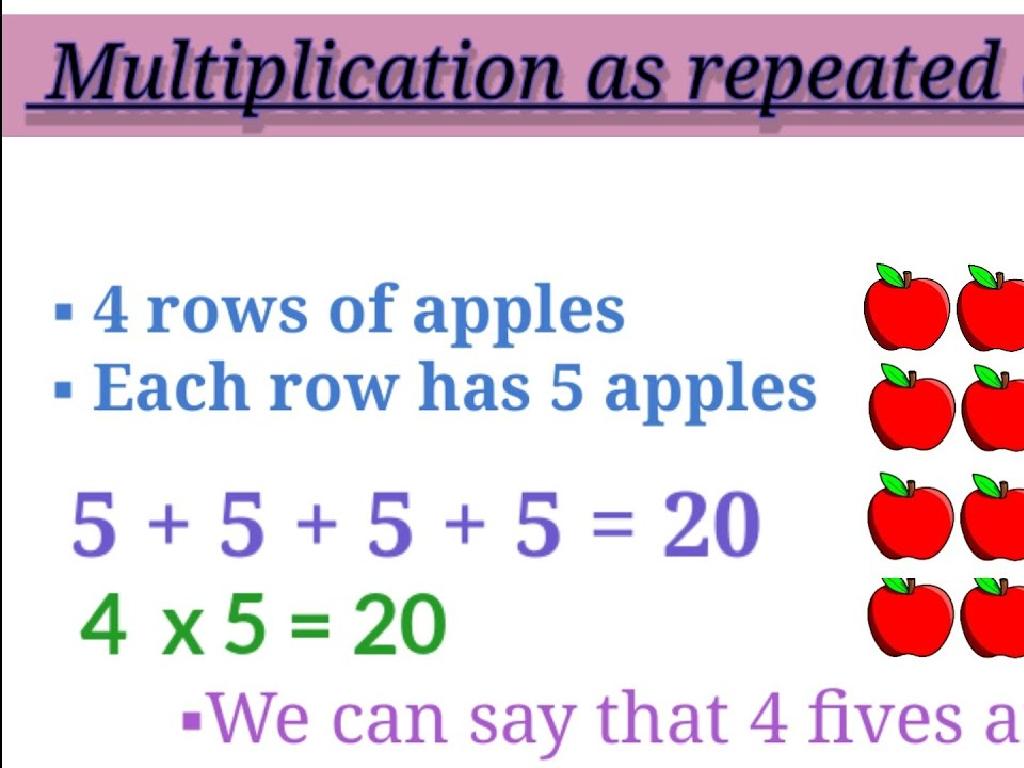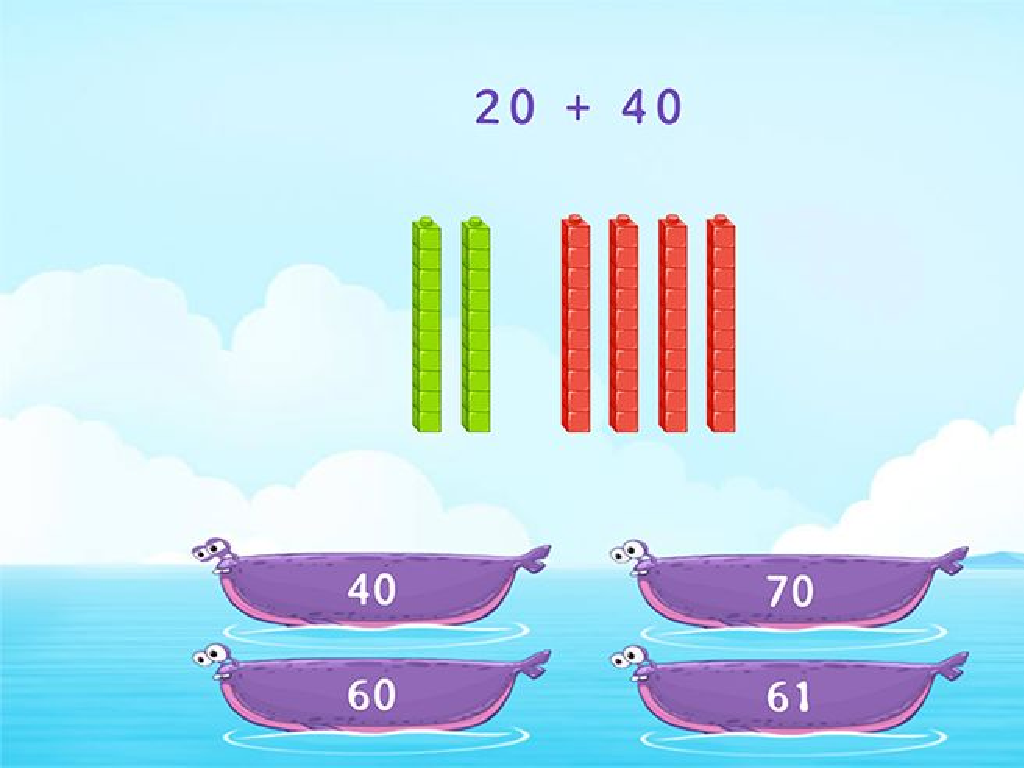Complete The Addition Or Subtraction Sentence
Subject: Math
Grade: Fourth grade
Topic: Add And Subtract Decimals
Please LOG IN to download the presentation. Access is available to registered users only.
View More Content
Welcome to Decimals: Adding & Subtracting
– Decimals represent parts of a whole
– Like pieces of a pie cut into 10 or 100 pieces
– Adding decimals: line up the decimal points
– Example: 0.75 + 0.25 equals 1.00
– Subtracting decimals: keep the decimal points aligned
– Example: 1.00 – 0.25 equals 0.75
– Decimals are used in money, measurements, and more
– Understanding decimals helps with everyday tasks
|
Begin the lesson by explaining that decimals are a way of representing fractions and parts of a whole, which is a concept they are familiar with. Emphasize the importance of aligning decimal points when adding or subtracting to avoid mistakes. Provide examples of adding and subtracting decimals, using relatable contexts such as money (dollars and cents) and measurements (meters and centimeters). Explain how decimals are practical and necessary for daily life, such as in shopping, cooking, and time management. Encourage students to think of other areas where they encounter decimals. This will help them understand the relevance and application of decimals beyond the classroom.
Understanding Decimals
– What is a decimal?
– A number with a decimal point to show a whole and its parts
– Decimals in whole numbers and parts
– Numbers left of the point are whole, right are fractional parts
– Decimals in everyday life
– Use decimals when dealing with money like $1.50 or measurements like 3.2 km
– Practice with money and measurements
– Example: $5.75 – $2.30 or adding 1.2 m to 3.4 m
|
This slide introduces the concept of decimals to fourth-grade students. Begin by explaining that a decimal is a way to represent whole numbers and their parts together. Emphasize the decimal point’s role in separating the whole number from the fractional part. Use relatable examples such as money and measurements to illustrate how decimals are used in everyday life. For instance, show how to subtract $2.30 from $5.75 or add 1.2 meters to 3.4 meters. Encourage students to think of other examples where they encounter decimals. This will help them understand the practical applications of decimals in addition and subtraction sentences.
Adding Decimals
– Line up decimal points
– Add like normal numbers
– Place decimal in the answer
– Example: 3.5 + 2.75
– Stack them vertically, align decimals, and add: 3.5 + 2.75 = 6.25
|
When teaching students to add decimals, emphasize the importance of aligning the decimal points to ensure accurate addition. Remind them that adding decimals is just like adding whole numbers, but they must include the decimal point in their final answer. Use the example 3.5 + 2.75 to demonstrate the process. Write the numbers vertically, align the decimal points, and then add as usual. Place the decimal point directly below the others in the answer. Encourage students to practice with more examples and provide immediate feedback. This slide is interactive and aims to build confidence in adding decimals through practice.
Subtracting Decimals
– Line up the decimal points
– Subtract numbers normally
– Example: 5.6 – 2.3
– Start with 5.6, subtract 2.3, equals 3.3
– Practice with different numbers
– Try 7.5 – 4.2 or 8.9 – 6.3 for practice
|
When teaching subtraction of decimals, emphasize the importance of aligning the decimal points vertically before proceeding with the subtraction. This ensures accuracy in the placement of the decimal in the answer. Use the example 5.6 – 2.3 to demonstrate the process, and then provide additional problems for the students to solve independently. Encourage students to check their work by adding the difference to the smaller number to see if it equals the larger number. This slide should help solidify the concept of decimal subtraction and prepare students for more complex problems.
Complete the Sentence – Addition with Decimals
– Fill in the blank to solve
– Example: 4.2 + ___ = 6.7
– What number when added to 4.2 gives 6.7?
– Find the number to add to 4.2
– Think: 6.7 minus 4.2 equals?
– Understand decimal addition
– Adding numbers with decimals, just like whole numbers
|
This slide is aimed at helping students practice completing addition sentences with decimals. Start by explaining that adding decimals follows the same principles as adding whole numbers. Use the example provided to illustrate how to find the missing number in an addition sentence. Encourage students to think in terms of ‘what do I add to the first number to get the second number?’ and remind them to line up the decimal points when adding. Have students practice with similar problems, ensuring they understand the concept of ‘carrying over’ when necessary, just as with whole number addition.
Complete the Sentence: Subtraction with Decimals
– Understanding subtraction sentences
– Finding the missing number
– What number is subtracted from 9.8 to get 3.4?
– Example: 9.8 – ___ = 3.4
– We start with 9.8 and want to end with 3.4, what do we subtract?
– Let’s solve it together!
– We’ll use subtraction to find the missing number step by step.
|
This slide is aimed at helping students understand how to complete subtraction sentences involving decimals. Start by explaining that a subtraction sentence shows how much one number is reduced by another to get a result. Use the example provided to illustrate the concept. Walk the students through the process of finding the missing number by reversing the subtraction process, which in this case involves finding the difference between 9.8 and 3.4. Encourage the students to think aloud as they work through the problem and to check their work by adding the missing number to the smaller number to see if it equals the larger number. This reinforces the relationship between addition and subtraction and helps solidify their understanding of decimal operations.
Let’s Practice: Adding and Subtracting Decimals
– Fill in the blank: 2.5 + ___ = 3.0
– What number added to 2.5 makes 3.0?
– Fill in the blank: 7.75 + ___ = 10
– What number added to 7.75 makes 10?
– Fill in the blank: 6.0 – ___ = 4.5
– What number subtracted from 6.0 gives 4.5?
– Fill in the blank: 8.2 – ___ = 5
– What number subtracted from 8.2 gives 5?
|
This slide is a classroom activity designed to help students practice adding and subtracting decimals. For each sentence, students must determine the missing number that completes the equation. Encourage students to think about the relationship between the numbers and use inverse operations to find the answers. For example, to find the missing number in an addition sentence, they can subtract the known number from the sum. For subtraction sentences, they can add the known difference to the smaller number to find the original amount. Provide guidance on aligning decimal points and remind students to check their work. Possible activities include pairing students to solve problems together, using manipulatives like base-ten blocks, or drawing number lines to visualize the problems.
Class Activity: Decimal Bingo
– Receive your unique Bingo card
– Solve decimal problems on the card
– Use addition or subtraction to find the answers
– Match answers to Bingo grid
– Each answer corresponds to a spot on your card
– Aim for five correct in a row
– Shout ‘Bingo!’ when you get five in a row
|
This activity is designed to make learning decimals fun through a game of Bingo. Each student will receive a Bingo card filled with decimal addition or subtraction problems instead of numbers. They must solve these problems and then mark the corresponding answer on their card. The first student to align five correct answers vertically, horizontally, or diagonally wins a prize. This encourages quick mental math and accuracy. Prepare different Bingo cards with a variety of problems to cater to different skill levels. Prizes can be simple, such as stickers or extra recess time. Make sure to go over the answers at the end to reinforce learning.
Fantastic Decimal Mastery!
– Excellent work with decimals
– Keep practicing with worksheets
– Practice makes perfect! Use your worksheets to review today’s lesson.
– More decimal fun next class
– Get ready for new challenges and games involving decimals.
– Remember to align the decimal points
– When adding or subtracting, decimals should be one under the other.
|
Congratulate the students on their hard work learning to add and subtract decimals. Remind them of the importance of practice to reinforce their skills, using the worksheets provided as a tool for this purpose. Give them a teaser of what’s to come in the next lesson to keep them excited about learning more about decimals. Emphasize the key strategy of aligning decimal points to ensure accuracy in their calculations. This wrap-up slide is meant to boost their confidence and prepare them for continued learning.





